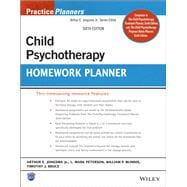Beneficial take-home assignments for young psychotherapy clients and their parents
The Child Psychotherapy Homework Planner, Sixth Edition provides ready-to-use, between-session assignments designed to fit most therapeutic modes. Organized by presenting problem, this homework planner covers 36 issues, including anxiety, depression, adoption, academic underachievement, ADHD, low self-esteem, and PTSD. In this new edition, the homework assignments have been modified to be more accessible to children. Assignment sheets can be easily photocopied, and they are also available online to download and print—making client-specific modification simple. This easy-to-use sourcebook features:
- Nearly 100 ready-to-copy exercises covering the most common issues encountered by children
- A format that’s easy to navigate, including cross-references to alternate assignments that are relevant across multiple presentations
- Expert guidance on how and when to make the most efficient use of the exercises
- Clearly referenced correspondence with the The Child Psychotherapy Treatment Planner for a complete treatment approach
The Child Psychotherapy Homework Planner is a high-quality resource that practitioners can use to improve care and accountability. This is a valuable planner that will save therapists time on office work so they can focus on patients.








